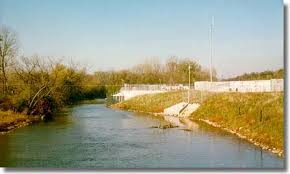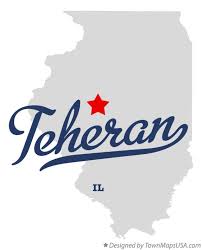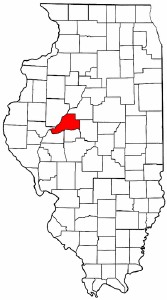Salt Creek History part 3
Upcoming Schedule
March 2-6- Salt Creek Township
March 9-13- Forest City Township
March 16- 20- Quiver Township
March 23-27- Manito Township
March 30-April 3- Lynchburg Township
April 6-10- Bath Township
April 13-17- Kilbourne Township
April 20-30 Mason City Township
May 4-8- Allen’s Grove
May 11-22- Havana Township
As a pioneer of the prairie, John Y. Lane settled west of where Mason
City now stands, in 1851, building a hut of poles, prairie grass and canvas,
where he and his family spent their first winter and summer in this township.
He was then well advanced in age, but was a Tennessean, who fought under
Old Hickory Jackson in the war of 1812, and was inured to hardships from his
youth. He was somewhat impetuous and visionary, and when the first line of
the Tonica & Petersburg Railroad was surveyed near his place, in 1856, he and
William Young prepared to lay out a town, and Mr. Lane built a large frame
house which he designed for a hotel, and which he was unable to finish. That
house now stands northwest of the West Side Schoolhouse in Mason City, and
was moved there in 1872, by Jeremiah Skinner.
About 1847, John L. Chase, who lived in the southwest part of the township, and was a very efficient business man, was appointed Postmaster, by which
the post office was removed from Walker’s Grove, but still retained the name
of Walker’s Grove Post Office. Here all the eastern part of the county
received and sent out mail, which was carried on horseback, once a week, to
and from Petersburg ; that is. once a week when the crossing at Salt Creek
bridge would permit, which was only about half the time. Sometimes there were three and four weeks that we would be totally shut out from all mail communication on this account, even down as late as 1856. Often, some anxious
person would take the chances of swimming the sloughs on horseback, and
bring the mail over in a grain-sack, locked with a cotton string. Mr. Chase
died in 1856, and William Warnock, Jr., who, in partnership with William
Young, kept a country store at the farm of the latter, was appointed Postmaster, soon after removed it, with the store, to Hiawatha, where the office was sus- pended in 1858, upon the location of one in Mason City.
In 1854, George Young erected a steam saw-mill a quarter of a mile south of
Big Grove Cemetery, and, the following year, Edward Sikes, Jr., moved the
George Virgin store-building, of which he had now become the proprietor, to that
place. Several dwelling-houses were soon after erected, and a flouring-mill
added to the saw-mill, when the place was given the romantic name of Hiawatha. John Pritchett, who afterward became a prominent hardware and grain
merchant in Mason City, and is now a commission merchant in St. Louis,
started a blacksmith-shop. Dr. William Hall, a good physician, located there
for the practice of medicine, and when the first line of the Tonica & Petersburg
Railroad struck that place, in 1856, the most extravagant hopes of the people
seemed about to be realized. But the railroad went four miles farther east ; Mason City sprung up, and Hiawatha went down, and now not a vestige of
the village remains to be seen. The old ” Timber Schoolhouse.” or Virgin Schoolhouse, was the for the two townships, now Mason City and Salt Creek, until 1857, and
was known as ”
Salt Creek Precinct.” The election of 1856 will never be for- gotten by any one who was an eye-witness to the scenes of that day at this
place. With politics at fever heat, and barrels of whisky as fuel to the political
fire, no words can adequately describe the hurrahing, quarreling, fighting and
confusion of that day, from early morn until dusky eve. At this schoolhouse, religious meetings were frequently held, and the stronghold of Satan was stormed upon the tactics of border warfare, that is, upon the
theory that there is more terror to the enemy in noisy demonstration than in
means of eifectual destruction. Sinners were held “breeze-shaken” over the
yawning abyss of the preacher’s most vivid imagination, and the mighty oaks
bowed their majestic heads to the thunders of Sinai, and one unused to such
demonstrations would think the “heavens were rolling together as a scroll.”
In 1857, a camp-meeting of three weeks’ duration was held in the grove about a half-mile southwest of George Lampe’s place, at which Elder Peter Cartwright made his last visit to this section. About three-quarters of a mile southwest of this, and, on the ridge a quarter of a mile east of where Michael Maloney’s house now stands, was the inevitable grog-shop that was always to be
found as near the sanctum sanctorum of the camp-meeting as the Jaw would permit. Here it was that the first and last murder in the township was
committed, for which William (Duff) Armstrong and James Henry Norris were
indicted at the following term of Court, and for which the latter served a term
of eight years in the Penitentiary at Joliet, and the former was acquitted
defended by Abraham Lincoln, as we have before stated. The name of the
murdered man was Metzker, a citizen of Menard County. It was done about
9 o’clock at night, by being struck on the head with the neck-yoke of a
wagon, which fractured his skull, and from which he died next day. Dr. J. P.
Walker, now of Mason City, conducted the post mortem examination.
Dr. J. P. Walker settled in the west part of this township, at the place now
owned and occupied by George McClintick. in 1849, and pursued the practice of
medicine, and carried on his farm until 1858, when he moved to Mason City.
Dr. A. R. Cooper settled on the farm now occupied by William McCarty about
the same time, but removed a few years later. About the same year, Dr. John.
Deskins built a hut and located a half-mile east of George Lampe’s place. He
built his house in the side of a ridge, so that the earth formed three sides of
his domicile; but, embedded in the earth as ii was, a tornado, in 1852, swept it away and scattered his goods for miles around, though, as by a miracle, none
of the family were seriously injured.




